 W
WAvgolemono or egg–lemon is a family of sauces and soups made with egg yolk and lemon juice mixed with broth, heated until they thicken. They are found in Greek, Arab, Sephardic Jewish, Turkish, Balkan and Italian cuisine.
 W
WBaklava is a layered pastry dessert made of filo pastry, filled with chopped nuts, and sweetened with syrup or honey. It was one of the most popular sweet pastries of Ottoman cuisine.
 W
WBörek is a family of baked filled pastries made of a thin flaky dough such as phyllo or yufka, typically filled with meat. It is found in the cuisines of Western Asia, the Balkans, the South Caucasus, the Levant, Central Asia, and other parts of Eastern Europe. A börek may be prepared in a large pan and cut into portions after baking, or as individual pastries. The top of the börek is occasionally sprinkled with sesame or nigella seeds.
 W
WBoza, also bosa, bozo is a fermented beverage popularly made in parts of North Africa, Central and Western Asia, Caucasus and Southeast Europe. It is a malt drink made by fermenting various grains: maize (corn) and wheat in Turkey, wheat or millet in Bulgaria and Romania, and barley in Ancient Egypt. It has a thick consistency, a low alcohol content, and a slightly acidic sweet flavor.
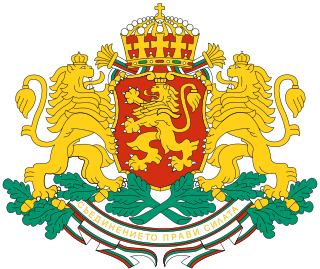 W
WBulgarian cuisine is a representative of the Mediterranean cuisine of Southeast Europe. It shares characteristics with other Balkan cuisines. Bulgarian cooking traditions are diverse because of geographical factors such as climatic conditions suitable for a variety of vegetables, herbs, and fruit. Aside from the vast variety of local Bulgarian dishes.
 W
WĆevapi or ćevapčići is a grilled dish of minced meat found traditionally in the countries of southeast Europe. It is considered a national dish of Bosnia and Herzegovina, and is also common in Bulgaria, Serbia, Croatia, Montenegro, North Macedonia, Kosovo, Slovenia, Albania, Romania and Austria.
 W
WA cremeschnitte is a vanilla slice or custard slice, a custard and chantilly cream cream cake dessert originating from the Austro-Hungarian Monarchy but whose exact origin is unknown.
 W
WDolma is a family of stuffed dishes found in the Balkans, South Caucasus, Central Asia and the Middle East, in which a vegetable or leaf is used as a container or wrapping for another food used as a filling. Common vegetables for stuffing are tomato, pepper, onion, zucchini, eggplant and pointed gourd. Stuffed cabbage rolls and vine leaves are also very popular, which are sometimes also called sarma. Meat dolmas are generally served warm, often with tahini or avgolemono sauce. Dolmas prepared with olive oil and stuffed with rice are generally served cold with a garlic-yogurt sauce.
 W
WFilo or phyllo is a very thin unleavened dough used for making pastries such as baklava and börek in Middle Eastern and Balkan cuisines. Filo-based pastries are made by layering many sheets of filo brushed with oil or butter; the pastry is then baked.
 W
WGibanica is a traditional pastry dish popular all over the Balkans. It is usually made with cottage cheese and eggs. Recipes can range from sweet to savoury, and from simple to festive and elaborate multi-layered cakes.
 W
WGüveç is a family of earthenware pots used in Balkan, Turkish, and Levantine cuisine, and various casserole or stew dishes cooked in them. The pot is wide and medium-tall, can be glazed or unglazed, and the dish in it is cooked with little or no additional liquid.
 W
WHalva refers to various local confection recipes in West Asia and its vicinity. The name is used for referring to a huge variety of confections, with the most geographically common variety based on fried semolina.
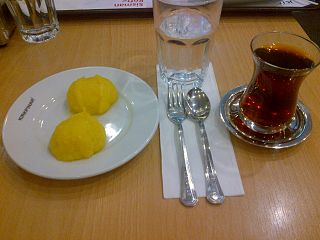 W
WHöşmerim or hoşmerim is a Turkish dessert popular in the Aegean, Marmara, Trakya and Central Anatolia regions of Turkey. It is sometimes called peynir helva or "cheese halva". It is generally consumed after a meal as a light dessert and may be topped with ice cream, honey or nuts.
 W
WKaymak or Sarshir is a creamy dairy food similar to clotted cream, made from the milk of water buffalo, cows, sheep, or goats in Central Asia, some Balkan countries, some Caucasus countries, Turkic regions, Iran and Iraq. In Poland, the name kajmak refers to a confection similar to dulce de leche instead.
 W
WKebabs are various cooked meat dishes with their origins in Middle Eastern cuisine. Numerous variants are popular around the world.
 W
WKofta is a family of meatball or meatloaf dishes found in the Indian subcontinent, South Caucasian, Middle Eastern, Balkan, and Central Asian cuisines. In the simplest form, koftas consist of balls of ground meat - usually beef, chicken, lamb or mutton, pork, or a mixture - mixed with spices or onions. In Muslim cultures, pork is not commonly used. In many areas in India, beef is not commonly used. In Greece and Cyprus, vegetarian versions are known as hortokeftedes, and often eaten during fasting periods such as Lent. An uncooked version is also made in Turkey, called çiğ köfte. In India, vegetarian varieties may use potato, calabash, paneer, or banana. In Europe, kofta is often served in a fast-food sandwich in kebab shops.
 W
WKoliva, also spelled kollyva, kollyba or colivă, is a dish based on boiled wheat that is used liturgically in the Eastern Orthodox Church for commemorations of the dead.
 W
WLapa (Turkish) or lapas is a kind of rice porridge or gruel eaten in the Balkans, Levant, and Middle East. It is made of just rice, water, and salt and has the consistency of a thick soup.
 W
WMacedonian cuisine ,, an aspect of Balkan cuisine, is the traditional cuisine of North Macedonia. It reflects Mediterranean and Middle Eastern influences and shares characteristics of other Balkan cuisines. The relatively warm climate of the country provides excellent growth conditions for a variety of vegetables, herbs and fruits. Macedonian cuisine is also noted for the diversity and quality of its dairy products, wines, and local alcoholic beverages, such as rakija.
 W
WMeze, mezze, or mazza is a selection of small dishes served as appetizers in parts of the Middle East, the Balkans, Greece, and North Africa. In some Middle Eastern and African regions where it is present, especially predominantly Muslim regions where alcohol is less common, meze is often served as a part of multi-course meals, while in Greece, Turkey, and the Balkans, they function more as snacks while drinking or talking.
 W
WMoussaka is an eggplant- and/or potato-based dish, often including ground meat, which is common in the Balkans and the Middle East, with many local and regional variations.
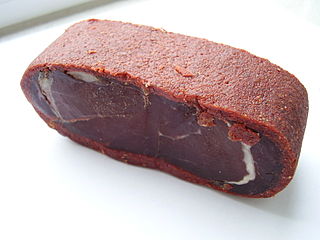 W
WPastırma or basturma, also called pastourma, basdırma, or basterma, is a highly seasoned, air-dried cured beef that is part of the cuisines of Armenia, Bulgaria, Egypt, Greece, Iraq and North Macedonia.
 W
WPasulj or grah, is a bean soup made of usually white, cranberry or pinto beans, and more rarely kidney beans, that is common in Albanian, Kosovo-Albanian, Serbian, Montenegrin, Bosnian and Croatian cuisine. It is normally prepared with meat, particularly smoked meat such as smoked bacon, sausage, and ham hock, and is a typical winter dish. Other commonly used ingredients include carrots and onions. Another version of the dish using baked beans is known as prebranac (пребранац). It has also spread via the diaspora, and is known in English as Serbian bean soup, and in German-speaking countries as Serbische Bohnensuppe. In North Macedonia, a spicy and thicker variant is known as tavče gravče.
 W
WPilaf, or pilau is a rice dish, or in some regions, a wheat dish, whose recipe usually involves cooking in stock or broth, adding spices, and other ingredients such as vegetables or meat, and employing some technique for achieving cooked grains that do not adhere.
 W
WPita or pitta, is a family of yeast-leavened round flatbreads baked from wheat flour, common in the Mediterranean, Middle East, and neighboring areas. It includes the widely known version with an interior pocket, also known as Arabic bread, Syrian bread, and other names, as well as pocketless versions such as the Greek pita, used to wrap souvlaki. The Western name pita may sometimes be used to refer to various other types of flatbreads that have different names in their local languages, such as numerous styles of Arab khubz (bread).
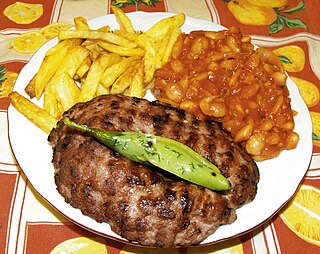 W
WPljeskavica, a grilled dish of spiced meat patty mixture of pork, beef and lamb, is a national dish of Serbia, also popular in Bosnia and Herzegovina, Croatia, Montenegro and North Macedonia. It is a main course served with onions, kajmak, ajvar (relish), and urnebes, either on plate with side dishes, or with lepinja. Recently, Pljeskavica has gained popularity elsewhere in Europe and is served in a few speciality fast food restaurants in Germany, Sweden, and Austria. Varieties include the "Leskovac Pljeskavica" very spicy with onions, "Šar Pljeskavica" stuffed with kačkavalj cheese, "Hajduk Pljeskavica" of beef mixed with smoked pork meat, and "Vranje Pljeskavica".
 W
WProja is a Balkan dish made of corn flour, baking powder, sunflower oil, sparkling water and salt. Proha is an alternative name used in Bosnia and Herzegovina.
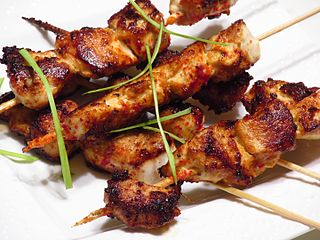 W
WRažnjići is a popular Balkan specialty of grilled meat on a skewer, equivalent of the Greek souvlaki and Turkish şaşlık. The name is derived from "ražanj" meaning "skewer".
 W
WRuske kape are a type of cake dessert served in Balkan countries, especially in Bosnia and Herzegovina, Croatia and Serbia. It usually comes in a 6-inch-wide (150 mm), round serving and includes coconut around the edge or sometimes crushed walnuts. The top is usually chocolate drizzled with vanilla. The center includes layers of alternating vanilla, chocolate, and sometimes a mocha flavor.
 W
WŠampita is a whipped meringue dessert with egg yolk crust, originating in the Balkans.
 W
WSelsko meso is a Balkan pork and mushroom stew. Typical ingredients include pork, onion bits, smoked meat, ground beef, tomatoes or ketchup, cream cheese, mushroom, peppers, spices, wine and salt. It is traditionally prepared in a clay pot.
 W
WStrained yogurt, Greek yogurt, yogurt cheese, sack yogurt, or kerned yogurt is yogurt that has been strained to remove most of its whey, resulting in a thicker consistency than regular unstrained yogurt, while still preserving the distinctive sour taste of yogurt. Like many types of yogurt, strained yogurt is often made from milk that has been enriched by boiling off some of its water content, or by adding extra butterfat and powdered milk. In Europe and North America, it is often made from low-fat or fat-free cow's milk. In Iceland, a similar product named skyr is made.
 W
WStuffed apples are made of apples stuffed with meat (lamb) and rice. The ingredients typically include green apples, minced meat, rice, onion, tomato paste, parsley, mint, cinnamon, salt, black pepper, and vegetable oil.
 W
WStuffed eggplants are a dish typical of many countries.
 W
WStuffed peppers is a dish common in many cuisines. It consists of hollowed or halved peppers filled with any of a variety of fillings, often including meat, vegetables, cheese, rice, or sauce. The dish is usually assembled by filling the cavities of the peppers and then cooking.
 W
WStuffed quinces are made of quinces stuffed with meat (lamb) and rice. The ingredients are ground meat, rice, quince, grape molasses, coriander, salt, and warm water.
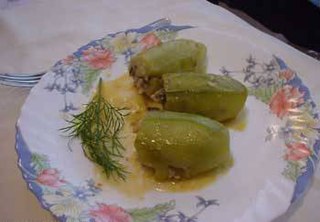 W
WStuffed squash, courgette, marrow, mahshi, or zucchini is a dish common in the region of the former Ottoman Empire from the Balkans to the Levant and Egypt, a kind of dolma. It consists of various kinds of squash or zucchini stuffed with rice and sometimes meat and cooked on the stovetop or in the oven. The meat version is served hot, as a main course. The meatless version is considered an "olive-oil dish" and is often eaten at room temperature or warm.
 W
WStuffed tomatoes are one of a number of dishes in which tomatoes are filled with ingredients, usually including rice.
 W
WA tahini roll or tahini bread roll is a sweet pastry found commonly in the cuisines of Armenia as Թահինով Հաց; Cyprus and Greece as ταχινόπιττα or τασιηνόπιττα; Turkey as tahinli çörek; and in Arab cuisine as khubz tahini. They are a popular street food in Cyprus.
 W
WTavče gravče is a traditional Macedonian dish. It is prepared with fresh beans and can be found in many restaurants in North Macedonia. It is also commonly eaten by the Macedonian diaspora. This meal is baked and served in a traditional unglazed earthenware pot. The name of the dish may be translated as "Beans on a tava". Tavče gravče is considered the national dish of North Macedonia. "Tavče gravče Tetovo style" is a popular regional variation.
 W
WTorshi are the pickled vegetables of many Middle Eastern and Balkan cuisines.
 W
WTripe chorba is a chorba (soup) made with tripe. It is widely considered to be a hangover remedy.
 W
WTulumba or Bamiyeh is a deep-fried dessert found in Iran and the regional cuisines of the former Ottoman Empire. It is a fried batter soaked in syrup, similar to jalebis and churros. It is made from unleavened dough lump given a small ovoid shape with ridges along it using a pastry bag or cookie press with a suitable end piece. It is first deep-fried to golden colour and then sugar-sweet syrup is poured over it when still hot. It is eaten cold, and is traditionally served for Persian New Years known as Nowruz and other special occasions.
 W
WTurkish delight or lokum is a family of confections based on a gel of starch and sugar. Premium varieties consist largely of chopped dates, pistachios, hazelnuts or walnuts bound by the gel; traditional varieties are often flavored with rosewater, mastic, Bergamot orange, or lemon. The confection is often packaged and eaten in small cubes dusted with icing sugar, copra, or powdered cream of tartar to prevent clinging. Other common flavors include cinnamon and mint. In the production process, soapwort may be used as an emulsifying additive.
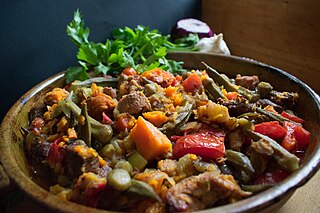 W
WTürlü is a casserole of Turkish cuisine. It is made of stewed vegetables and may also include stewed meat. Varieties of this dish are also found in Balkan cuisines. In particular, it is known as turli perimesh in Albania, tourlou or tourlou tourlou in Greece, and as turli tava in North Macedonia.
 W
WZelnik is a traditional pastry from the Balkans composed of thin layers of phyllo pastry filled with various combinations of sirene, eggs, sorrel, browned meat, leeks and rice. In winter, the filling traditionally includes brined cabbage, from which the dish derives its name: Bulgarian language: "зелe") meaning cabbage. Zelnik is often sometimes served with yoghurt and it is best eaten warm.